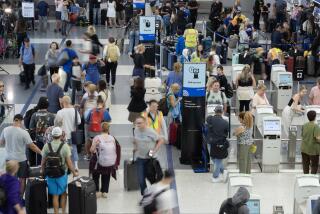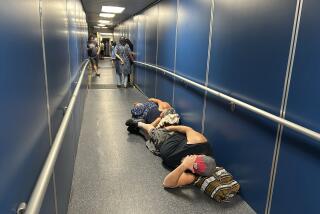Airports are testing thermal cameras and other technology to screen travelers for COVID-19
- Share via
Airports equipped with full-body scanners, metal detectors and face-recognition technology to identify potential terrorists are starting to make room for devices to target the latest global threat: travelers infected with the novel coronavirus.
Airports in the U.S. and overseas are testing thermal cameras, sanitation booths and other technologies in hopes of slowing the spread of the virus while reducing the risk of exposing airport screeners to the disease.
“This is going to be part of our normal travel system,” said Richard Salisbury, managing director and founder of Thermoteknix Systems, a British company that has developed thermal cameras for airport use. “It will be part of the fabric of our travel patterns.”
The pandemic has pushed demand for air travel down by as much as 95% in the U.S., and airport operators hope new screening technologies will give passengers renewed confidence to fly again.
At Los Angeles International Airport, once one of the nation’s busiest airports, interim Chief Executive Justin Erbacci recently announced the creation of a COVID-19 recovery task force that has started to evaluate using thermal cameras, touch-less kiosks and other technologies to screen passengers for the virus.
“We have had many vendors reach out to us regarding specific technologies that they have, which may address the goals of this task force,” said Becca Doten, an airport spokeswoman.
Some devices, such as thermal cameras, got a workout screening passengers during the Severe Acute Respiratory Syndrome (SARS) crisis in 2003 and the Ebola outbreak in 2014.
But like the COVID-19 pandemic, the use of technology to target travelers infected with the novel coronavirus is expected to be much more intense and widespread than during previous outbreaks.
“This is going to be part of our normal travel system.”
— Richard Salisbury, managing director and founder of Thermoteknix Systems.
Hong Kong International Airport last month began to test a booth about the size of an outhouse that takes the temperature of a person, via a thermal camera, before the individual is allowed to enter the sealed enclosure.
Inside, a process that relies on ultraviolet light and “nano needles” to pierce the cell membrane of bacteria and viruses is used to disinfect the people who enter. The people who enter the booth are also doused with a sanitation spray. The process takes about 40 seconds. The system is now being tested on airport staff.
In addition, the Hong Kong airport is deploying autonomous cleaning robots equipped with virus-killing ultraviolet light, applying antimicrobial coatings to frequently touched surfaces and using air sterilizers to disinfect toilets and other passenger areas.
Stationary thermal cameras are most likely to be used at airports and other public facilities because the technology has been used in the past and because the cameras can gauge the temperature of a passenger from seven to 15 feet away.
The advantage of the thermal cameras is that human screeners don’t have to touch or stand near passengers. Instead, screeners can monitor a television screen from a distance. The screen shows the thermal images of passengers and their temperatures.
In the past, most airports in the U.S. have employed screeners to take temperatures with hand-held thermometers. At least two medical screeners at LAX have tested positive for the coronavirus.
The U.S. Department of Defense is already using thermal cameras to screen people entering military facilities. Two of Carnival’s cruise lines, Costa and Aida, are installing thermal cameras to screen passengers and crews for the virus.
Large companies such as Tyson Foods Inc. and General Motors Co. are also using thermal cameras to screen employees before they enter their workplaces.
With thermal cameras at airports, a passenger who generates an unusually high temperature is automatically denied entry and is directed to a separate area where nurses or other trained professionals can perform a more thorough exam.
Developers of such systems say the thermal cameras are designed to avoid slowing down the regular security screening process. The accuracy of the device is within less than one degree Fahrenheit, they said.
A thermal camera system developed by Texas-based Infrared Cameras Inc. is being tested at Dulles International Airport in Washington and at Tampa International Airport, said Gary Strahan, chief executive and founder of the company.
His company’s cameras already have been used for screening by factories, manufacturers and hospitals and are now in high demand at airports, he said, adding that publicly operated airports don’t move as fast as private companies to install the new technology.
“We are looking at rolling this technology out to all the airports because it has to be there,” he said.
Salisbury, founder of the company that makes a thermal camera-based system called the FevIR Scan, said his system has been used since 2003 in Asia, the Middle East and Africa for health scanning during previous outbreaks.
In the last few months, he said, his company’s business has jumped by about 30% thanks to demand for the technology, and he expects the FevIR Scan to be installed in a major British airport this week. He declined to name the airport, saying he was obligated not to divulge the name without the approval of the airport.
Medical experts point out that people infected with the coronavirus can, at times, have normal body temperatures and still pass along the virus to others. The makers of the thermal cameras acknowledge that their systems are not guaranteed to identify every infected traveler but can help slow the pandemic by zeroing in on those with unusually high temperatures.
Parsons Corp., a Virginia based engineering company, is going beyond simply using technology to take the temperatures of passengers at airports.
Parsons recently announced the launch of a touch-free health screening kiosk that can take a passenger’s temperature as well as respiration and pulse rates. By connecting to a smartphone app, the kiosk can also ask for other health information.
Based on the health information and the other data, the kiosk can give travelers a green light to continue on to the airport security screening line or be denied boarding.
Parsons is talking to several U.S. airports about testing the kiosk, including LAX, said Carey Smith, president and chief executive of Parsons.
“For everyone to get back to work, we need solutions that make everyone feel comfortable,” she said.
More to Read
Inside the business of entertainment
The Wide Shot brings you news, analysis and insights on everything from streaming wars to production — and what it all means for the future.
You may occasionally receive promotional content from the Los Angeles Times.











